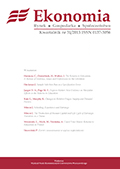Ewolucja kontroli wewnętrznej w kierunku efektywnościowym w instytucjach publicznych
The Evolution of Internal Control In Public Institutions Towards Effectiveness
Author(s): Leszek ChodorowskiSubject(s): Economy
Published by: Uniwersytet Warszawski - Wydział Nauk Ekonomicznych
Keywords: ekonomia instytucjonalna; efektywność; strategia; kontrola wewnętrzna; audyt wewnętrzny
Summary/Abstract: This article describes the growing importance of effectiveness in the internal control system in public institutions. This new “effective” approach to internal control has already been noted in literature. Moreover, the Regulation on public finance dated 27 August 2009 introduced the notion of the effective “managerial control” in the area of functioning of the Polish public administration and local governments. The COSO I model also underlines the necessity of permanent research of the operations productivity and the evaluation of effectiveness of the internal control system as a whole in a given company, which is especially important for the management. Additionally, the INTOSAI guidance and the Standards of European Commission no 1341/2007 point to the effective aspects of the internal control system. The full and efficient internal control system in an institution should consist of 3 integrated lines: current control, control conducting after carrying out operations and also internal audit. The internal audit has an important role in the internal control system efficiency evaluating for the management. The organizational structure of the institution has crucial influence on the internal control system and its effectiveness. The hierarchic structure is a natural environment favorable for the internal control system, however the process approach usually stimulates and facilitates the research of effectiveness of control mechanisms built into a given business process. The effective internal control system can support the implementation of strategy in a given institution by periodically checking the level of achievement of strategic sub-purposes. Finally, it can observe the gradual evolution of internal control towards effectiveness in central banks and other public institutions, which means a better awareness of “control culture” among staff and a better quality of Corporate Governance.
Journal: Ekonomia. Rynek, Gospodarka, Społeczeństwo
- Issue Year: 2013
- Issue No: 32
- Page Range: 77-101
- Page Count: 25
- Language: Polish

